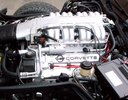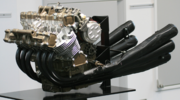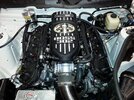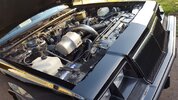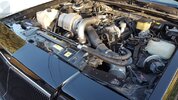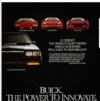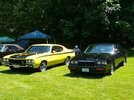A few recent discussions had me rethinking about my decades-past fascination with motors and vehicles. I remember pouring over technical illustrations of experimental cars (Vector, 60’s and 70’s proposed mid-engine Corvette proposals) and the fascination with motors as the years went by and clever technology permeated the industry. I imagine it had always been there, but by the early 70’s with the oil embargo and emissions restrictions taking foot, things were getting interesting on a tangible level.
A few favorites were the Corvette LT5 motor (with Lotus influence), the Honda NR500 and 750 motorcycle motor incorporating oval pistons PLUS two connecting rods and eight valves per cylinder, and no specific engine, but the experimental use of engine and engine parts made of ceramic, through the early 80’s and into the 90’s.
In practical engines, I would have discussion turn to various straight six motors- the long lasting AMC/Jeep unit and the Dodge/Plymouth/Chrysler “slant six” line. Neither that advanced, but good design execution. Same to be said for the BMW’s straight six motor- not as spritely at advanced as the M3 four bangers, but a great engine nonetheless, and one I still admire. Oh- and let’s not forget the VW VR6- a squashed-sized motor sporting a V engine configuration squashed into a narrower, staggered semi-straight six shape. I used to be able to take this pair of GTIs on work assignments- a burnt Orange 1.8t turbo four cylinder and a metallic nature green VR6. Both were a blast, but I had a thing for the VR6.
A throwback motor- the Vincent company’s V-twin. To think when this motor was designed (1940s), and how 20 years later Egli was reworking the frame to handle the motor and turning out formidable machines, to it’s collector status and real world drivability today. And while performance that’s perhaps not exotic superbike level 70+ Years on, it’s absolutely nothing to scoff at.
Of course there are plenty more motors out there worth discussing- the mid century Chrysler turbine, the Wankel rotary, a few heart-shaped three valve engines Honda made- the list could be expansive.
with that said, what were some of your favorites? Anything goes- from a humble and reliable engine to an ultra exotic experiment. I’m interested in seeing where this goes.
A few favorites were the Corvette LT5 motor (with Lotus influence), the Honda NR500 and 750 motorcycle motor incorporating oval pistons PLUS two connecting rods and eight valves per cylinder, and no specific engine, but the experimental use of engine and engine parts made of ceramic, through the early 80’s and into the 90’s.
In practical engines, I would have discussion turn to various straight six motors- the long lasting AMC/Jeep unit and the Dodge/Plymouth/Chrysler “slant six” line. Neither that advanced, but good design execution. Same to be said for the BMW’s straight six motor- not as spritely at advanced as the M3 four bangers, but a great engine nonetheless, and one I still admire. Oh- and let’s not forget the VW VR6- a squashed-sized motor sporting a V engine configuration squashed into a narrower, staggered semi-straight six shape. I used to be able to take this pair of GTIs on work assignments- a burnt Orange 1.8t turbo four cylinder and a metallic nature green VR6. Both were a blast, but I had a thing for the VR6.
A throwback motor- the Vincent company’s V-twin. To think when this motor was designed (1940s), and how 20 years later Egli was reworking the frame to handle the motor and turning out formidable machines, to it’s collector status and real world drivability today. And while performance that’s perhaps not exotic superbike level 70+ Years on, it’s absolutely nothing to scoff at.
Of course there are plenty more motors out there worth discussing- the mid century Chrysler turbine, the Wankel rotary, a few heart-shaped three valve engines Honda made- the list could be expansive.
with that said, what were some of your favorites? Anything goes- from a humble and reliable engine to an ultra exotic experiment. I’m interested in seeing where this goes.

